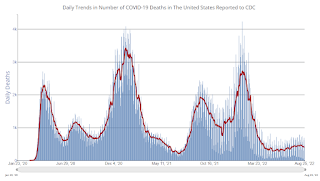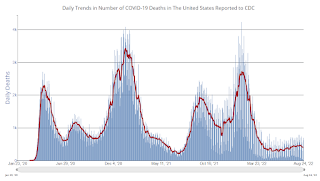by Calculated Risk on 8/26/2022 09:16:00 PM
Friday, August 26, 2022
COVID August 26, 2022, Update on Cases, Hospitalizations and Deaths
On COVID (focus on hospitalizations and deaths):
| COVID Metrics | ||||
|---|---|---|---|---|
| Now | Week Ago | Goal | ||
| New Cases per Day2 | 88,594 | 95,609 | ≤5,0001 | |
| Hospitalized2 | 32,403 | 35,061 | ≤3,0001 | |
| Deaths per Day2 | 392 | 438 | ≤501 | |
| 1my goals to stop daily posts, 27-day average for Cases, Currently Hospitalized, and Deaths 🚩 Increasing 7-day average week-over-week for Cases, Hospitalized, and Deaths ✅ Goal met. | ||||
 Click on graph for larger image.
Click on graph for larger image.This graph shows the daily (columns) and 7-day average (line) of deaths reported.
Black Knight: Median House Prices Declined in July; First Decline in 32 Months
by Calculated Risk on 8/26/2022 03:12:00 PM
Today, in the Calculated Risk Real Estate Newsletter: Black Knight: Median House Prices Declined in July; First Decline in 32 Months
A brief excerpt:
Important caveats: In normal times, median house prices flatten or decline seasonally in the 2nd half of the year. So, a decline in July isn’t unusual.There is much more in the article. You can subscribe at https://calculatedrisk.substack.com/
Also, the median price is distorted by the mix of homes sold. The repeat sales indexes - like Case-Shiller and FHFA - are better measures of house price movements, but median prices can be a leading indicator of price changes.
...
From Andy Walden at Black Knight: Something Had to Give: Home Prices Down for First Time In 32 Months
Annual home price growth still clocked in at 14.3% – more than three times the long-run average – but most of that appreciation occurred in the last months of 2021 and earlier this year. Such strong annual growth rates can hide underlying weakness. Month-over-month data gives us a much clearer picture of just how much – and how quickly – the housing market has shifted.
The median home price fell by 0.77% in July, the largest single-month drop since January 2011. On a seasonally adjusted basis, July’s dip ranked among the 10 largest monthly declines on record, dating back more than 30 years.
Q3 GDP Forecasts: Around 1%
by Calculated Risk on 8/26/2022 12:33:00 PM
From BofA:
[W]e continue to track 3Q GDP at 0.5% q/q saar [August 26 estimate]From Goldman:
emphasis added
The personal consumption details were softer than our previous assumptions, and we lowered our Q3 GDP tracking estimate by 0.2pp to +1.0% (qoq ar). [August 26 estimate]And from the Altanta Fed: GDPNow
The GDPNow model estimate for real GDP growth (seasonally adjusted annual rate) in the third quarter of 2022 is 1.6 percent on August 26, up from 1.4 percent on August 24. After this morning's releases from the US Census Bureau and the US Bureau of Economic Analysis, an increase in the nowcast of third-quarter real net exports was partially offset by a decrease in the nowcast of third-quarter real personal consumption expenditures and third-quarter real gross private domestic investment. [August 26 estimate]
Fed Chair Powell: "Higher interest rates ... will also bring some pain to households and businesses"
by Calculated Risk on 8/26/2022 10:06:00 AM
From Fed Chair Powell: Monetary Policy and Price Stability (watch on YouTube here)
Excerpt:
Restoring price stability will take some time and requires using our tools forcefully to bring demand and supply into better balance. Reducing inflation is likely to require a sustained period of below-trend growth. Moreover, there will very likely be some softening of labor market conditions. While higher interest rates, slower growth, and softer labor market conditions will bring down inflation, they will also bring some pain to households and businesses. These are the unfortunate costs of reducing inflation. But a failure to restore price stability would mean far greater pain.
...
July's increase in the target range was the second 75 basis point increase in as many meetings, and I said then that another unusually large increase could be appropriate at our next meeting. We are now about halfway through the intermeeting period. Our decision at the September meeting will depend on the totality of the incoming data and the evolving outlook. At some point, as the stance of monetary policy tightens further, it likely will become appropriate to slow the pace of increases.
Restoring price stability will likely require maintaining a restrictive policy stance for some time. The historical record cautions strongly against prematurely loosening policy.
Personal Income increased 0.2% in July; Spending increased 0.1%
by Calculated Risk on 8/26/2022 08:36:00 AM
The BEA released the Personal Income and Outlays report for July:
Personal income increased $47.0 billion (0.2 percent) in July, according to estimates released today by the Bureau of Economic Analysis. Disposable personal income (DPI) increased $37.6 billion (0.2 percent) and personal consumption expenditures (PCE) increased $23.7 billion (0.1 percent).The July PCE price index increased 6.3 percent year-over-year (YoY), down from 6.8 percent YoY in June.
The PCE price index decreased 0.1 percent. Excluding food and energy, the PCE price index increased 0.1 percent. Real DPI increased 0.3 percent in July and real PCE increased 0.2 percent; goods increased 0.2 percent and services increased 0.2 percent.
emphasis added
The following graph shows real Personal Consumption Expenditures (PCE) through July 2022 (2012 dollars). Note that the y-axis doesn't start at zero to better show the change.
 Click on graph for larger image.
Click on graph for larger image.The dashed red lines are the quarterly levels for real PCE.
Personal income and PCE were below expectations.
Thursday, August 25, 2022
Friday: Personal Income & Outlays, Fed Chair Powell
by Calculated Risk on 8/25/2022 09:08:00 PM
Friday:
• At 8:30 AM ET, Personal Income and Outlays, July 2022. The consensus is for a 0.6% increase in personal income, and for a 0.4% increase in personal spending. And for the Core PCE price index to increase 0.3%. PCE prices are expected to be up 6.4% YoY, and core PCE prices up 4.7% YoY.
• At 10:00 AM, Speech, Fed Chair Jerome Powell, Economic Outlook, At the Jackson Hole Economic Policy Symposium
• Also at 10:00 AM, University of Michigan's Consumer sentiment index (Final for August). The consensus is for a reading of 55.1.
On COVID (focus on hospitalizations and deaths):
| COVID Metrics | ||||
|---|---|---|---|---|
| Now | Week Ago | Goal | ||
| New Cases per Day2 | 90,675 | 97,183 | ≤5,0001 | |
| Hospitalized2 | 32,903 | 35,314 | ≤3,0001 | |
| Deaths per Day2 | 389 | 441 | ≤501 | |
| 1my goals to stop daily posts, 27-day average for Cases, Currently Hospitalized, and Deaths 🚩 Increasing 7-day average week-over-week for Cases, Hospitalized, and Deaths ✅ Goal met. | ||||
 Click on graph for larger image.
Click on graph for larger image.This graph shows the daily (columns) and 7-day average (line) of deaths reported.
Freddie Mac: Mortgage Serious Delinquency Rate decreased in July
by Calculated Risk on 8/25/2022 07:31:00 PM
Freddie Mac reported that the Single-Family serious delinquency rate in July was 0.73%, down from 0.76% June. Freddie's rate is down year-over-year from 1.74% in July 2021.
Freddie's serious delinquency rate peaked in February 2010 at 4.20% following the housing bubble and peaked at 3.17% in August 2020 during the pandemic.
These are mortgage loans that are "three monthly payments or more past due or in foreclosure".

Mortgages in forbearance are being counted as delinquent in this monthly report but are not reported to the credit bureaus.
This is very different from the increase in delinquencies following the housing bubble. Lending standards have been fairly solid over the last decade, and most of these homeowners have equity in their homes - and they will be able to restructure their loans once they are employed.
The Sellers Strike and Housing Inventory
by Calculated Risk on 8/25/2022 01:12:00 PM
Today, in the Calculated Risk Real Estate Newsletter: The Sellers Strike and Housing Inventory
A brief excerpt:
Starting in July, new listings declined year-over-year according to my local market data, and also Realtor.com and Redfin. Realtor.com economist Jiayi Xu noted today:There is much more in the article. You can subscribe at https://calculatedrisk.substack.com/New listings–a measure of sellers putting homes up for sale–were again down 12% from one year ago. This week marks a seventh straight week of year over year declines in the number of new listings coming up for sale and a second consecutive week with double digit declines, suggesting that homeowners are less eager to list homes for sale compared to last year, even though today’s median listing price is more than 14% higher.And from Redfin: Housing Market Update: Slowdown Starts to Ease as Drop in New Listings Hampers Supply
emphasis added
...
The bottom line is inventory is still increasing due to less demand, but inventory growth has slowed due to fewer new listings.
This could delay the return to more normal inventory levels (I’ve been comparing to 2019). As always, I’ll be watching inventory closely.
August Vehicle Sales Forecast: Unchanged at 13.3 million SAAR
by Calculated Risk on 8/25/2022 10:37:00 AM
From WardsAuto: August U.S. Light-Vehicle Sales Running Flat with July; Inventory Set to Increase (pay content). Brief excerpt:
"The overriding factor is that even without headwinds such as higher interest rates, low consumer confidence, elevated fuel prices and an inventory mix favoring more expensive models, the general lack of availability of new vehicles would keep sales from being significantly stronger."
 Click on graph for larger image.
Click on graph for larger image.This graph shows actual sales from the BEA (Blue), and Wards forecast for August (Red).
The Wards forecast of 13.3 million SAAR, would be mostly unchanged from last month, and up 2% from a year ago (sales started to weaken in mid-2021, due to supply chain issues).
Q2 GDP Growth Revised Up to minus 0.6% Annual Rate
by Calculated Risk on 8/25/2022 08:41:00 AM
From the BEA: Gross Domestic Product (Second Estimate) and Corporate Profits (Preliminary), Second Quarter 2022
Real gross domestic product (GDP) decreased at an annual rate of 0.6 percent in the second quarter of 2022, according to the "second" estimate released by the Bureau of Economic Analysis. In the first quarter, real GDP decreased 1.6 percent.Here is a Comparison of Second and Advance Estimates. PCE growth was revised up from 1.0% to 1.5%. Residential investment was revised down from -14.0% to -16.2%.
The GDP estimate released today is based on more complete source data than were available for the "advance" estimate issued last month. In the advance estimate, the decrease in real GDP was 0.9 percent. The update primarily reflects upward revisions to consumer spending and private inventory investment that were partly offset by a downward revision to residential fixed investment
...
Real gross domestic income (GDI) increased 1.4 percent in the second quarter, compared with an increase of 1.8 percent in the first quarter. The average of real GDP and real GDI, a supplemental measure of U.S. economic activity that equally weights GDP and GDI, increased 0.4 percent in the second quarter, compared with an increase of 0.1 percent in the first quarter.
emphasis added


